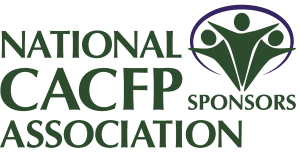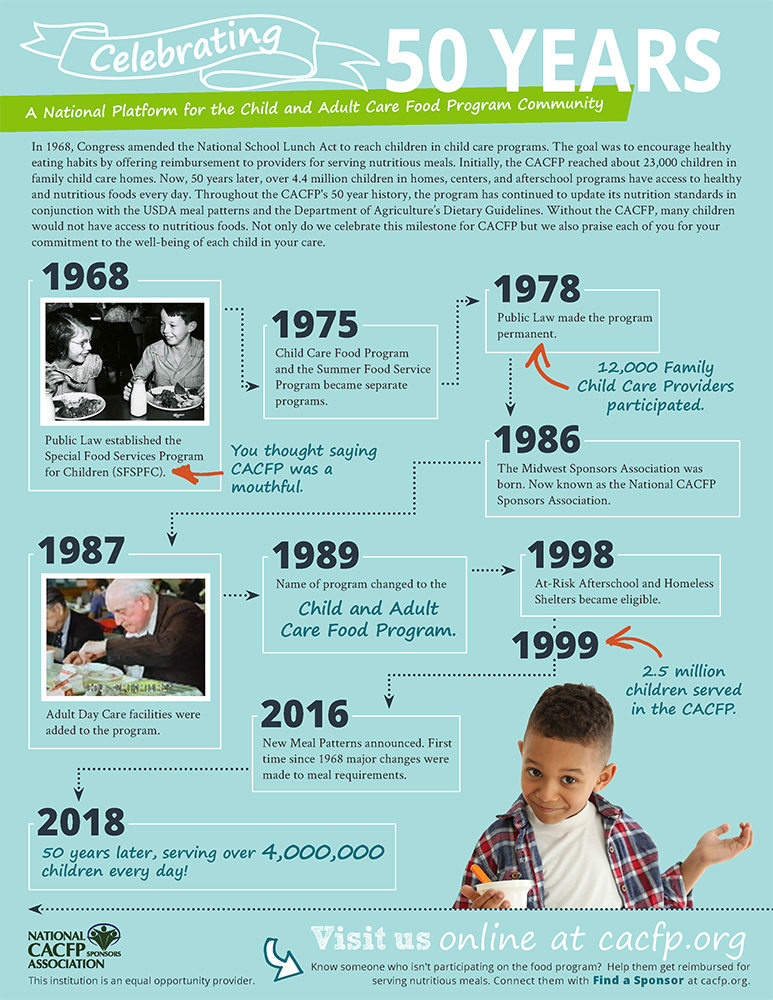Celebrating 50 Years
In 1968, Congress amended the National School Lunch Act to reach children in child care programs. Throughout the CACFP's more than 50-year history, the program has continued to update its nutrition standards in conjunction with the USDA meal patterns and the Department of Agriculture's dietary guidelines. Download the abbreviated timeline, or view a more complete outline below of the policies that shaped the CACFP into what it is today.
1853
The Children's Aid Society of New York Provided this country's first school food service program.
1913
There were thirty cities with school food service programs, most of them operated by charities.
1930
The federal government stepped in with financial aid and surplus agriculture products for school food service programs. During World War II, these commodities were diverted to the war effort.
1946
The 79th Congress passed the National School Lunch Act and established the National School Lunch Program (NSLP). The governmental requiremental guidelines, established at this time, defined nutritional requirements.
1962
The Act was amended to make the program more effective by providing free or reduced price lunches to children. Although authorized in 1962, this amendment was not funded until 1966.
1965
Government began providing support for child care feeding programs within child care centers. This was the forerunner of the Child and Adult Care Food Program (CACFP).
1966
With the passage of the Child Nutrition Act, among other things, a pilot breakfast program in schools was started.
1968
Congress instituted the Child Care Food Program as part of the Child Nutrition Program to improve nutritional status and prevent disease in children attending child care centers.
1975
Public Law 94-105 expanded the program to include state-licensed family child care homes and all private or public nonprofit child care facilities, including those serving non-needy areas. Participating family child care homes needed the sponsorship of a qualified institution or organization.
1976
Amendments were passed which did the following:
- Established the Nutrition Education and Training (NET) Program, which provides nutrition training for food service personnel and child care facilities.
- Revised the summer feeding program into the Summer Food Service Program we know today.
- Strengthened the admission of the NSLP and required greater accountability of program funds.
- Gave the Secretary of Agriculture the authority to regulate the sale of competitive foods in schools, including such items as soda water, frozen desserts, candy and chewing gum until the end of the last lunch period.
1978
The Child Care Food Program (CCFP) became permanent by Public Law 94-627. The program was modified in three major areas:
- The cash was changed from an income to a reimbursement.
- Reimbursement for each child changed to a flat rate in family child care homes, regardless of family income.
- USDA would pay sponsoring agency administrative expenses.
1980
Rules and Regulations implementing this law went into effect on May 1, 1980. There was no legislation to reduce federal assistance for child nutrition programs to aid the economic recovery.
1989
The CCFP expanded to allow adults in adult day care centers to participate. The name was then changed to the Child and Adult Care Food Program.
1996
Welfare reform legislation is enacted that creates significant changes to the CACFP.
1997
A two-tier system of reimbursement is implemented.
1998
Public Law 105-336 authorized CACFP reimbursement for snacks to children through age 18 in "at-risk" afterschool centers. The law also consolidated benefits for homeless children, enabling public or private nonprofit emergency shelters that provide residential and food services to homeless families to participate in CACFP. Eligible shelters were authorized to receive reimbursement for serving up to three meals each day to homeless children who reside there. Unlike most other CACFP facilities, a shelter does not have to be licensed to provide day care. It must, however, meet any health and safety codes that are required by state or local law.
2000
The Agricultural Risk Protection Act of 2000 (P.L. 106-224) made changes designed to strengthen program management. It added new eligibility criteria for institutions, requirements for approval of institutions, monitoring requirements for State agencies and sponsoring organizations, parent notification, management improvement training, and procedures on withholding of administrative funds. It also expanded the "at-risk" afterschool care component of CACFP to allow reimbursement for suppers to children through age 18 in afterschool care programs in six states.
2000
The Consolidated Appropriation Act, 2001 (P.L. 106-554) extended eligibility to for-profit child care centers and outside-of-school-hours care centers serving low-income children in all states, from December 21, 2000 through September 30, 2001.
2001
The Agriculture, Rural Development, Food and Drug Administration, and Related Agencies Appropriations Act, 2002 (P.L. 107-76) authorized supper benefits in afterschool care programs in Illinois (in addition to Delaware, Michigan, Missouri, New York and Oregon) and extended CACFP eligibility to for-profit centers serving low-income children through fiscal year 2002.
2004
Child Nutrition and WIC Reauthorization Act of 2004 (P.L. 108-265) increased the minimum level of State Administrative expense funding and changed tiering determinations from 3 years to 5 years. Examined reducing paperwork burden from the regulations and recordkeeping requirements for State Agencies and institutions.
2009
Agriculture, Rural Development, Food and Drug Administration, and Related Agencies Appropriations Act, 2010 (P.L. 111-80) continued expansion of additional meal benefits to at-risk afterschool care programs in 13 states and the District of Columbia. It also authorized $8 million in grants to improve health and wellness projects in child care settings.
2010
The Healthy, Hunger-Free Kids Act (S. 3307) broadened the Afterschool Meal Program to cover all 50 states, supported the expansion of direct certification for school meals, improved area eligibility rules so more family child care homes can use the CACFP, changed summer food rules to make it easier for nonprofits to operate, made important reforms in the nutritional quality of food served in schools and child care, and made "competitive" food sold or offered in schools more nutritious. Research continues to prove that proper nutrition in young children not only contributes to their physical growth, but to their intellectual and emotional development as well. All private sponsors must be tax-exempt. Amounts of funds provided by CACFP are based on costs for administration and a national formula on number of homes sponsored.
2016
USDA announces changes to the Child and Adult Care Food Program meal patterns. The changes are part of a broad effort to align child nutrition programs with the nutrition best practices outlined by the Dietary Guidelines for Americans, new scientific research, and recomendations by organizations such as the American Academy of Pediatrics. This is the first time since 1968 that major changes were made to meal requirements.

